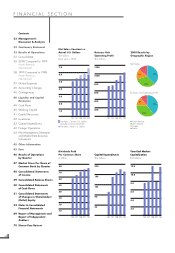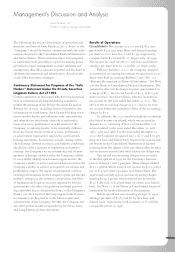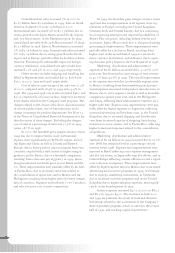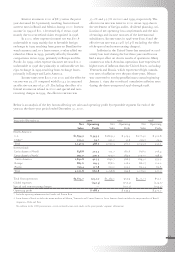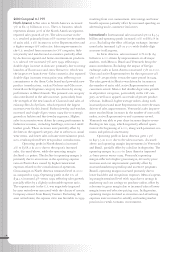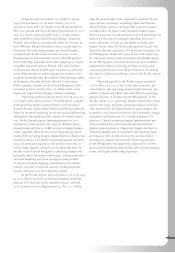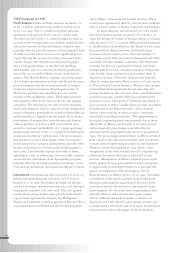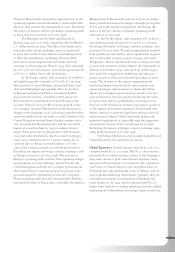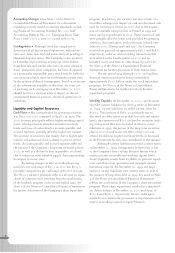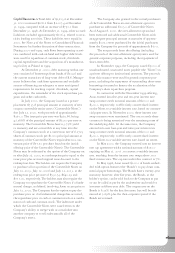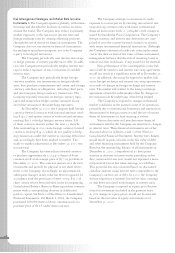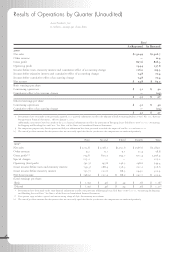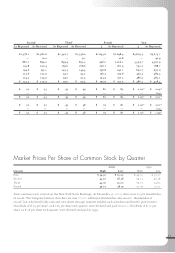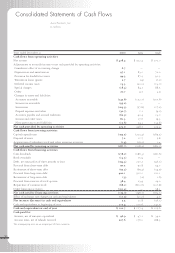Avon 2000 Annual Report Download - page 12
Download and view the complete annual report
Please find page 12 of the 2000 Avon annual report below. You can navigate through the pages in the report by either clicking on the pages listed below, or by using the keyword search tool below to find specific information within the annual report.
In connection with the May 1998 Bond issuance,
Avon entered into a five-year interest rate swap contract
with a notional amount of $50.0 to effectively convert
fixed interest on a portion of the Bonds to a variable inter-
est rate, based on libor.
During 1997, the Company issued $100.0 of
6.55% notes, due August 1, 2007, to pay down commer-
cial paper borrowings.
During 1996, the Company entered into an agree-
ment (the “credit facility”), which expires in 2001, with
various banks to amend and restate the five-year, $600.0
revolving credit and competitive advance facility agree-
ment. The Company is currently negotiating with various
banks to renew this credit facility and expects to have a
final agreement by the end of the second quarter of 2001.
Within this facility, the Company is able to borrow, on an
uncommitted basis, various foreign currencies.
The credit facility is primarily to be used to finance
working capital, provide support for the issuance of com-
mercial paper and support the stock repurchase program.
At the Company’s option, the interest rate on borrowings
under the credit facility is based on libor or the higher
of prime or federal fund rates. The credit facility has an
annual facility fee of $.4. The credit facility contains a
covenant for interest coverage, as defined. The Company
is in compliance with this covenant. At December 31,
2000 and 1999, the Company has $29.9 and $226.4,
respectively, outstanding under a $600.0 commercial
paper program supported by the credit facility.
The Company has uncommitted lines of credit
available of $49.0 in 2000 and 1999 with various
banks that have no compensating balances or fees. As
of December 31, 2000 and 1999, $11.1 of these lines
are being used for letters of credit. In addition, as of
December 31, 2000 and 1999, there were international
lines of credit totaling $449.5 and $399.5, respectively,
of which $74.8 and $81.6, respectively, were outstanding.
Inventories > Avon’s products are marketed during 12 to
26 individual sales campaigns each year. Each campaign
is conducted using a brochure offering a wide assortment
of products, many of which change from campaign to
campaign. It is necessary for Avon to maintain relatively
high inventory levels as a result of the nature of its busi-
ness, including the number of campaigns conducted
annually and the large number of products marketed.
Avon’s operations have a seasonal pattern characteristic of
many companies selling cft, fashion jewelry and acces-
sories, gift and decorative items, and apparel. Holiday
sales cause a peak in the fourth quarter, which results in
the build up of inventory at the end of the third quarter.
Inventory levels are then reduced by the end of the fourth
quarter. Inventories of $610.6 at December 31, 2000 were
$87.1 higher than 1999 as a result of worldwide inven-
tory investments due to sales increases; an increase in
beauty inventories to protect service levels, primarily in
the u.s. and Europe; transitional start-up related to new
distribution/manufacturing facilities in Taiwan, Mexico
and Poland; and European new market entries. It is
Avon’s objective to continue to manage purchases and
inventory levels maintaining the focus of operating the
business at efficient inventory levels. However, the addi-
tion or expansion of product lines, which are subject to
changing fashion trends and consumer tastes, as well as
planned expansion in high growth markets, may cause the
inventory levels to grow periodically.
Capital Expenditures > Capital expenditures during 2000
were $193.5 (1999–$203.4). These expenditures were
made for capacity expansion in high growth markets,
maintenance of worldwide facilities, contemporization
and replacement of information systems, the new Internet
strategy and a new manufacturing facility in Poland.
Numerous construction and information systems projects
were in progress at December 31, 2000 with an estimated
cost to complete of approximately $130.0. Capital expen-
ditures in 2001 are currently expected to be in the range
of $200.0–$220.0. These expenditures will include
improvements on existing facilities, continued invest-
ments for capacity expansion in high growth markets,
facility modernization, information systems, including
spending on the new Internet strategy, and equipment
replacement projects.
Foreign Operations > For the three years ended 2000,
1999 and 1998, the Company derived approximately 60%
of its consolidated net sales and consolidated operating
profit from operations from its subsidiaries outside of
North America. In addition, as of December 31, 2000 and
1999, these subsidiaries comprised approximately 51% of
the Company’s consolidated total assets.
Avon’s operations in many countries utilize numer-
ous currencies. Avon has significant net assets in Brazil,
Mexico, the United Kingdom, Japan, Argentina, Canada,
the Philippines and Poland. Changes in the value of
non-hyperinflationary countries’ currencies relative to
42


